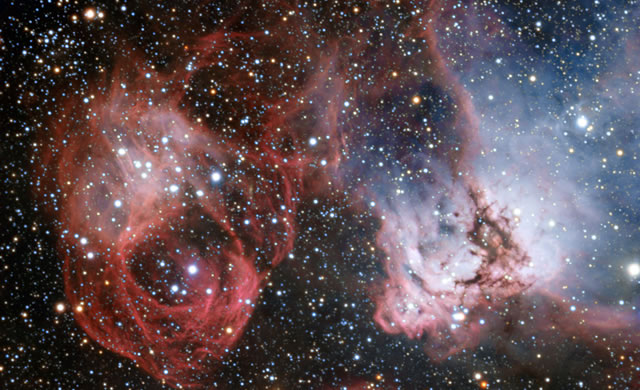
Credit: ESO
La Grande Nube di Magellano è una delle galassie più vicine alla nostra. Gli astronomi hanno sfruttato la potenza del VLT (Very Large Telescope) dell’ESO per esplorarne una delle regioni meno note. Questa nuova immagine mostra nubi di gas e polvere in cui si stanno formando nuove stelle calde che scolpiscono i dintorni di strane forme. L’immagine mostra anche gli effetti della morte delle stelle – filamenti creati da un’esplosione di supernova.
A soli circa 160 000 anni luce da noi (eso1311) nella costellazione del Dorado, la Grande Nube di Magellano è una delle nostre vicine galattiche più prossime: sta formando attivamente nuove stelle in regioni così luminose che alcune sono visibili da Terra ad occhio nudo, per esempio la nebulosa Tarantola (eso1033). Questa nuova immagine, ottenuta con il VLT dell’ESO all’Osservatorio del Paranal in Cile, esplora una zona nota come NGC 2035 (a destra), chiamata a volte anche Nebulosa Testa di Drago. NGC 2035 è una regione HII, o nebulosa a emissione, formata da nubi di gas che risplendono a causa della radiazione energetica emessa dalle giovani stelle. Questa radiazione strappa gli elettroni dagli atomi del gas, elettroni che alla fine si ricombinano con altri atomi ed emettono luce. Grumi scuri di polvere, mescolati con il gas, assorbono la luce, creando contorte tracce e forme scure nella nebulosa. La struttura filamentosa a sinistra nell’immagine non è invece il risultato della nascita delle stelle, ma piuttosto della loro morte. È stata creata da uno degli eventi più violenti che accadono nell’Universo – un’esplosione di supernova. Queste esplosioni sono così brillanti da poter eclissare l’intera galassia ospite, prima di diminure di intensità e sparire dalla vista in alcune settimane o mesi (si veda anche eso1315 e potw1323a). Guardando questa immagine può essere difficile cogliere la vastità di queste nubi – diverse centinaia di anni luce. E non si trovano neppure nella nostra galassia, ma molto oltre. La Grande Nube di Magellano è enorme, ma se confrontata con la nostra galassia è modesta, raggiunge appena i 14 000 anni luce, circa 10 volte meno della Via Lattea.
Fonte/Leggi tutto → ESO.org
The Large Magellanic Cloud is one of the closest galaxies to our own. Astronomers have now used the power of ESO’s Very Large Telescope to explore one of its lesser known regions. This new image shows clouds of gas and dust where hot new stars are being born and are sculpting their surroundings into odd shapes. But the image also shows the effects of stellar death — filaments created by a supernova explosion.
Located only about 160 000 light-years from us (eso1311) in the constellation of Dorado (The Swordfish), the Large Magellanic Cloud is one of our closest galactic neighbours. It is actively forming new stars in regions that are so bright that some can even be seen from Earth with the naked eye, such as the Tarantula Nebula (eso1033). This new image, taken by ESO’s Very Large Telescope at the Paranal Observatory in Chile, explores an area called NGC 2035 (right), sometimes nicknamed the Dragon’s Head Nebula. NGC 2035 is an HII region, or emission nebula, consisting of clouds of gas that glow due to the energetic radiation given off by young stars. This radiation strips electrons from atoms within the gas, which eventually recombine with other atoms and release light. Mixed in with the gas are dark clumps of dust that absorb rather than emit light, creating weaving lanes and dark shapes across the nebula. The filamentary shapes to the left in the image are the not the results of starbirth, but rather stellar death. It was created by one of the most violent events that can happen in the Universe — a supernova explosion [1]. These explosions are so bright that they often briefly outshine their entire host galaxy, before fading from view over several weeks or months (also see eso1315 and potw1323a). From looking at this image, it may be difficult to grasp the sheer size of these clouds — they are several hundred light-years across. And they are not in our galaxy, but far beyond. The Large Magellanic Cloud is enormous, but when compared to our own galaxy it is very modest in extent, spanning just 14 000 light-years — about ten times smaller than the Milky Way.
Source/Continue reading → ESO.org

















